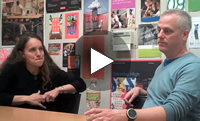
Photo by Alan Kupchick
Art Center faculty members Brian Boyl and Krystina Castella have both taken somewhat non-traditional routes in their careers. Boyl, director of interactive design in the Graphic Design Department, has a degree in physics, studied film and animation, has created computer software and produced video games. Castella created her own product development, manufacturing and licensing company; helps people start businesses and license products; and has written five popular cookbooks; the most recent, A World of Cake, named by Publisher’s Weekly as one of the best cookbooks of 2010. And this are just a few of the many noteworthy things these two have accomplished.
Also interesting—Boyl and Castella are spouses, meeting 20 years ago this month. Intrigued and curious about what motivates them to teach, how students have changed over the past two decades, and what it’s like to work with one’s significant other, we sat down with the couple for a chat.
Dotted Line: How did you two meet?
Brian Boyl: We met in 1991 at a Valentine’s Day party that a mutual friend of ours held for people who didn’t have dates. I was in film school then…
Krystina Castella: …and I was working a corporate job at Disney. We met at the party and got along really well. He called me the next day to ask me out, and I was eating a popsicle while we talked. I wrote about this in the introduction to my popsicle book, because I actually ended up saving the popsicle and freezing it.
Boyl: Yes, that popsicle went with us, every time we moved. It lasted for years. But sadly, it didn’t survive our last move.
Dotted Line: Does it take a while for students to realize you’re married?
Castella: Yes, it’s funny—it’s the same thing every term. Many people at Art Center don’t realize we’re married. People that we’ve known for a long time do, but students are always new and don’t know at first; it’s always a shock. They seem to figure it out around Weeks 5 and 6. A student will come in and say to me, “I saw you with my other teacher,” or, “You were in the parking lot with Brian…”
Boyl: Or, “How do you know each other?” and, “I saw you two leaving campus in the same car….”
Castella: We teach in different departments, but we do have students that cross over. It’s great, we really get to know the student when that happens. We ask each other, “So how are they doing in your class?”
Dotted Line: Why do you teach?
Boyl: I love giving back to the younger generation. I also find teaching personally inspiring, because it’s always about the next thing. It’s always different, and always new—especially in the area where I teach, which is on the cutting edge of everything. And I find students tend to push me in my own creativity. And, you’re dealing with people, so it’s a lot of fun. I think I have the best job in the world.
Castella: I think for me, it’s more because I’ve always enjoyed teaching—I held art classes in my backyard for neighborhood kids when I was in the sixth grade. I teach to help people fulfill their dreams, in terms of a very specific goal. I think I want that excitement of someone getting their product out there, and I feel like I have the skills to be able to help them do that.
Boyl: It’s very transformational to know that you are probably setting the platform for someone’s life. It’s kind of stressful too. You’re helping change someone’s life.
Castella: Definitely. And like Brian said, I learn so much from the students. I take what I know and I’m able to help them, but I’m also learning from what they’re doing.
Dotted Line: You’ve both been teaching for some time. Have students changed over the years?
Boyl: Oh, yeah, they’re different. There’s a whole different emphasis that you have to apply. The relationship between instructor and student used to be much more of a “student looking to you as the authority figure” type of thing. Today, they still look to you as the authority, but the way I think that this group of students connects with adults is more peer‑to‑peer than in the past.
Castella: It comes from parenting models—how parents help kids make decisions. Students today are very confident. And they feel they know a lot about technology, because their parents didn’t grow up with it, but they did. So it’s a different type of student.
Boyl: I’m just floored by how much technology they know right off the bat, it’s really interesting. But on the flipside, there are things that you have to make sure that you teach them.
The professional world is rough, and the expectations placed on Art Center grads are extremely high. So as instructors, we have to prepare students to respond to these expectations by the time they graduate. And I think that’s the challenge today—we’re puting more work into achieving these expectations.
Dotted Line: What is it like working with your spouse?
Castella: We carpool, but we rarely see each other on campus. But I’m always thinking about what we’re working on, what we’re doing. It can be hard to leave it “at work,” because you know that it’s always there.
Boyl: For instance, last weekend, we found ourselves waking up on Saturday morning talking about, this, that or the other in terms of Art Center. And then we just said, “OK, no more talking Art Center from Saturday at noon until Sunday night.” Sometimes we have to set up moratoriums.
Castella: And in terms of design—Brian is in digital design and I’m in industrial design. Twenty years ago those creative fields were very different. So while we were both in the creative field, back then we had very different jobs. But today, Brian also teaches in the Product Design Department, and interfacing interaction design is key to product development these days. Who would have thought that would be something that we would ever have in common?
Dotted Line: I know you published a book, Nature’s Alphabet, together. Have you collaborated on other projects together?
Boyl: Yes, off and on we do. I’d say every couple of years we do something together. The “Nature’s Alphabet” project was a big one, it took probably five years total.
Castella: It became a traveling exhibit as well, and last year, we licensed it to the Natural History Museum of London. But it was something that started out as this fun project between the two of us.
Dotted Line: Is there anything that you are currently working on together?
Boyl: We’re currently putting together a book called Easing Into The Wilderness, which is totally not design-related. It’s for people who are interested in hiking or backpacking or camping like we are. We often take two-week, 150-mile hikes. You don’t just start out doing a trip like that. You have to ease into the wilderness.
Dotted Line: What advice would you give aspiring artists and designers?
Castella: Do what you love. That’s number one. It’s about trying to figure out your unique voice. Like, the fact that I’m an industrial designer making cookbooks—I’m able to bring something that’s completely new to the cookbook world. It’s about finding your unique voice, and finding what you can bring to the table that someone else can’t.
Boyl: Also, I’d say to look at trends and see where the planet is going. Realize there’s more than just your local surroundings and that thing that’s due tomorrow. You really have to take a step back. I think that the economy is going to reconfigure itself. Big players will no longer be the big players, and small players are going to be big ones, and where will it all lead? So it’s important to understand who you are, and what your strengths are, and then where things are going and how you can best leverage your skills.









